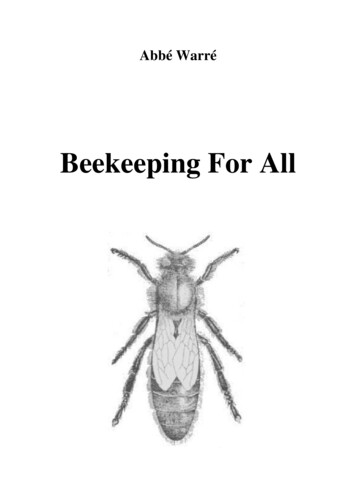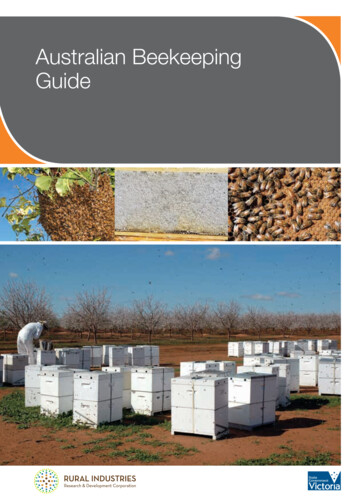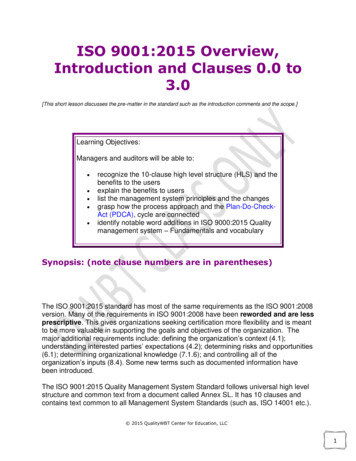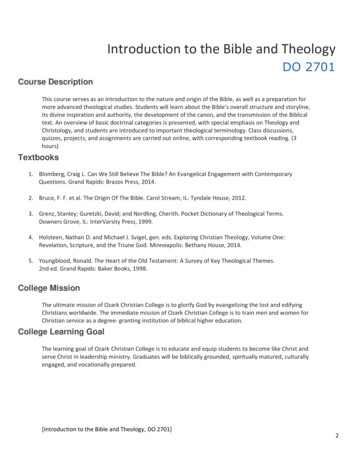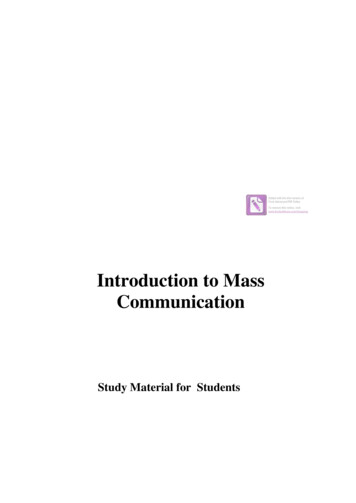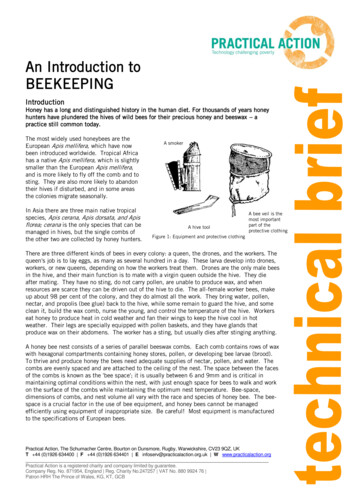
Transcription
An Introduction toBEEKEEPINGIntroductionHoney has a long and distinguished history in the human diet. For thousands of years honeyhunters have plundered the hives of wild bees for their precious honey and beeswax – apractice still common today.The most widely used honeybees are theEuropean Apis mellifera, which have nowbeen introduced worldwide. Tropical Africahas a native Apis mellifera, which is slightlysmaller than the European Apis mellifera,and is more likely to fly off the comb and tosting. They are also more likely to abandontheir hives if disturbed, and in some areasthe colonies migrate seasonally.In Asia there are three main native tropicalspecies, Apis cerana, Apis dorsata, and Apisflorea; cerana is the only species that can bemanaged in hives, but the single combs ofthe other two are collected by honey hunters.A smokerA hive toolA bee veil is themost importantpart of theprotective clothingFigure 1: Equipment and protective clothingThere are three different kinds of bees in every colony: a queen, the drones, and the workers. Thequeen's job is to lay eggs, as many as several hundred in a day. These larva develop into drones,workers, or new queens, depending on how the workers treat them. Drones are the only male beesin the hive, and their main function is to mate with a virgin queen outside the hive. They dieafter mating. They have no sting, do not carry pollen, are unable to produce wax, and whenresources are scarce they can be driven out of the hive to die. The all-female worker bees, makeup about 98 per cent of the colony, and they do almost all the work. They bring water, pollen,nectar, and propolis (bee glue) back to the hive, while some remain to guard the hive, and someclean it, build the wax comb, nurse the young, and control the temperature of the hive. Workerseat honey to produce heat in cold weather and fan their wings to keep the hive cool in hotweather. Their legs are specially equipped with pollen baskets, and they have glands thatproduce wax on their abdomens. The worker has a sting, but usually dies after stinging anything.A honey bee nest consists of a series of parallel beeswax combs. Each comb contains rows of waxwith hexagonal compartments containing honey stores, pollen, or developing bee larvae (brood).To thrive and produce honey the bees need adequate supplies of nectar, pollen, and water. Thecombs are evenly spaced and are attached to the ceiling of the nest. The space between the facesof the combs is known as the 'bee space'; it is usually between 6 and 9mm and is critical inmaintaining optimal conditions within the nest, with just enough space for bees to walk and workon the surface of the combs while maintaining the optimum nest temperature. Bee-space,dimensions of combs, and nest volume all vary with the race and species of honey bee. The beespace is a crucial factor in the use of bee equipment, and honey bees cannot be managedefficiently using equipment of inappropriate size. Be careful! Most equipment is manufacturedto the specifications of European bees.Practical Action, The Schumacher Centre, Bourton on Dunsmore, Rugby, Warwickshire, CV23 9QZ, UKT 44 (0)1926 634400 F 44 (0)1926 634401 E infoserv@practicalaction.org.uk W www.practicalaction.orgPractical Action is a registered charity and company limited by guarantee.Company Reg. No. 871954, England Reg. Charity No.247257 VAT No. 880 9924 76 Patron HRH The Prince of Wales, KG, KT, GCB
BeekeepingPractical ActionBees need a supply of food and water to live, and during dry periods the beekeeper may have tosupplement natural sources. As a general rule, attempts to begin beekeeping should start withthe area's existing bees, techniques, and equipment, which will all have been adapted for thelocal circumstances.EquipmentMost of the equipment needed for smallscale beekeeping can be made at villagelevel. It can be helpful to import basicequipment to serve as prototypes for localmanufacturers. For practising on a largescale, some specialised equipment willprobably need to be bought, such as honeygates, special filtering gauze, and gaugesto determine honey quality.The ends ofthe front andrear panelsare nailed tothe sidepanelsSmokerA beekeeper uses a smoker to producecool smoke to calm the bees. The smokerconsists of a fuel box containingsmouldering fuel (for example dried cowdung, hessian, or cardboard) with abellows attached. The beekeeper puffs alittle smoke near the entrance of the hivebefore it is opened, and gently smokes thebees to move them from one part of thehive to another.Protective clothingAdequate protective clothing givesbeginner beekeepers confidence, but moreexperienced beekeepers find that toomuch protective clothing makes it difficultto work sufficiently gently with the bees,and it is very hot. Always wear white orlight-coloured clothing when working withbees - they are much more likely to stingdark-coloured clothing. It is mostimportant to protect the face, especiallythe eyes and mouth; a broad-rimmed hatwith some veiling will suffice. Individualitems of clothing must be impermeable tobee stings, and every joint between themmust be bee-tight; rubber bands canprevent bees from crawling up trouser legsor shirtsleeves. Some people find that agood way to protect their hands is to put aplastic bag over each hand, secured at thewrist with a rubber band.Hive toolsThe hive tool is a handy piece of metalwhich is used to prise boxes apart, scrapeoff odd bits of beeswax, separate frameends from their supports, and so on. Theycan be made from pieces of flat steel, andscrewdrivers are often used. It is possible2Mark out andcut triangularentranceholes 2.5cmwide by2.5cm deepin the frontpanel, thennail the topto the base.The top barsmust be builtaccurately. Youwill need to cut27 of them andthe ends (a)must be shapedto the angle ofthe sides of thehive.The 27 top bars should fit without any gaps or spacesFigure 2: A Kenya top-bar hive. This hive issuitable for African bees, but may need adjustingfor Asian or European use. Any wood that isresistant to sun and rain and will not warp issuitable. (Drawing from Beekeeping for Beginners(1989) courtesy of GRATIS)
BeekeepingPractical Actionto use an old knife for this job, but knife blades tend to be too flexible and give insufficientleverage.BeehivesA beehive is any container provided forhoney bees to nest in. The idea is toencourage the bees to build their nest insuch a way that it is easy for thebeekeeper to manage and exploit them.Traditional hivesThese are made from whatever materialsare available locally: typically hollowedout logs, bark formed into a cylinder, claypots, woven grass, or cane. They are usedto encourage bees to nest in a site that isaccessible by the beekeeper.(a)Movable frames can be spun in a radial (a) or tangential (b)extractor Both of these can be adapted to take comb from the topbar hives by making wire mesh cages that sit where the framesnormally would A third option (not shown) is for flat, round meshtrays that stack inside the cylinder.The bees build their nest inside thecontainer, just as they would build itin a naturally occurring cavity. Eventually thebeekeeper plunders the nest to obtain crops ofhoney and beeswax. Bees may or may not bekilled during this process, depending on the skillof the beekeeper. If the colony is destroyed, thehive will remain empty for a while. If there areplenty of honey bee colonies in the area, theneventually a swarm may settle in the empty hiveand start building a new nest. Traditionalbeekeepers often own 200 hives, and expectonly a proportion of these to be occupied by beesFigure 3: Honey extractorsat any time.(b)All the requirements for traditional beekeepers will be available locally, but beekeepers can behelped by the provision of protective clothing, smokers, and containers for the honey, and withhelp in locating markets for their products.Movable frame hivesThese are the hives used in industrialised countries and in some countries in the South wherebeekeeping is a major industry, such as Mexico and Brazil. The objective of movable-frame hivebeekeeping is to obtain the maximum honey crop, season after season, with the least disruptionof the colony. These rectangular wooden or plastic frames have two major advantages: They allow easy inspection and manipulation of colonies. They allow very efficient honey harvesting because the honeycombs, within their frames, canbe emptied of honey and then returned to the hive.Frame hives must be constructed with precision. Frames are contained within boxes and eachhive consists of a number of boxes placed on top of each other. Often a 'queen excluder', a metalgrid with holes that allows only the smaller worker bees to pass through, is used to isolate thebrood in the bottom-most boxes. The rest of the boxes will contain only honey.Intermediate technology hivesIntermediate technology hives combine the advantages of frame hives with low cost and theability to manufacture locally. The hive consists of a container with a series of 'top bars', onwhich the bees are encouraged to build their combs. These top bars then allow individual combsto be lifted from the hive by the beekeeper. The containers for the hives may, like traditional3
BeekeepingPractical Actionhives, be built from whatever materials are locally available. Top-bar hives can also be kept nearthe home and moved between flowering crops, enabling women to keep bees.The only items in the top-bar hive which need to be built with precision are the top barsthemselves; they must provide the same spacing of combs within the hive as the bees would usein their natural nest. The natural comb spacing is the distance between the centres of adjoiningcombs, and this spacing will depend upon the species and race of honey bees which are beingused. As a very general guide, Apis mellifera of European origin need top bars 35mm wide, Apismellifera in Africa need 32mm, and Apis cerana in Asia need 30mm. The best way to determinethe optimum width is to measure the spacing between combs in a wild nest of the same bees.The volume of the brood box should equate roughly with the volume of the cavity occupied bywild-nesting honey bees.Making a startA good way to begin beekeeping, especially in Africa, is to bait an empty hive to attract a swarm.Set up a hive and either rub it inside with some beeswax or lavender to give it an attractive smell,or leave some attractive food for the bees: granulated sugar or cassava powder will work. Youcould also put some honey on the tops of the top bars. The bees will not be able to get at it andtake it away to another hive, but the scent will still remain to attract them. This will only besuccessful in areas where there are still plenty of honey bee colonies. Another option is to transfera colony from the wild into the hive. The wild colony will already have a number of combs andthese can be carefully tied on to the top bars of the hive, making sure that you include the broodcombs and the queen. One of the best ways to get started in beekeeping is with the assistance ofa practising, local beekeeper.Harvesting honey and beeswaxHoney is harvested at the end of a flowering season. The beekeeper selects those combs whichcontain ripe honey, covered with a fine layer of white beeswax. These combs are usually theoutside-most ones. Combs containing any pollen or developing bees should be left undisturbed.Honey will keep a long time if it is clean and sealed in an airtight container, but will deterioraterapidly and ferment if it has absorbed water. Preventing this from happening is crucial in honeyharvesting.Harvesting the combsHarvesting should be carried out in the evening or the early morning. Gentleness is the key tosuccessful colony manipulation, so learn to carry out this process swiftly but calmly to avoidupsetting your bees. Put on your protective clothing. Get your smoker, brush or quill, knife or hive tool, and a rust- proof container in which to putthe honeycomb. Load your smoker, and puff some smoke gently around the hive for a few minutes. Wait a fewmore minutes, then puff smoke around the entrance holes. After puffing the smoke, open the lid. Knock the top bars to see which of them have combs; they will sound heavier than emptyones. Use the knife or hive tool to remove the first bar from one end of the hive. Puff smoke gently into the gap to drive the bees to the other side of the hive. Start removing the bars one by one, until you get to the first comb, which will be white andnew. It may be empty or it may contain some unripened honey. Replace it and leave thecomb for the bees to develop. Remove only the capped or partly capped combs, which will be quite heavy. Use a brush orfeather to sweep any bees back into the hive. Cut the comb off, leaving about 2cm for the bees to start building on again. Put the comb ina container and replace the top bar. Carryon harvesting until you come across a brood comb, which will be dark in colour andcontain pollen too. Leave this honey for the bees.4
Beekeeping Practical ActionStart the process again at the other end of the hive.Close the hive carefully, replacing the lid.Honey extractionThe honeycomb can be simply cut into pieces and sold as fresh, cut comb honey. Alternatively,the honey and comb can be separated and sold as fresh honey and beeswax.It is important when processing honey to remember that it is hygroscopic and will absorbmoisture, so all honey processing equipment must be perfectly dry.The most common traditional methods of honey extraction are squeezing or burning the combs.Burning the honeycomb is wasteful and makes the quality of both the wax and the honey inferior;it should be avoided at all costs. If your quantity of honey or financial resources are small, thensqueezing the honey out by hand is probably the most viable option. The honey extracted by thismethod will have to be strained through several increasingly finer meshes to remove any bits ofwax or debris, ending with something like muslin cloth. It is very important that this procedurebe carried out hygienically, and that the honey is not left exposed to the air, where it will pick upmoisture and deteriorate.Another good way of extracting honey from top-bar or movable frame hives is a radial or tangentialextractor. This is a cylindrical container with a centrally-mounted fitting to support combs orframes of uncapped honey, and a mechanism to rotate the fitting (and the combs) at speed. Thehoney is thrown out against the side of the container and runs down to the bottom, where it iscollected and then drained off with a tap. Most manufactured extractors are made to hold framesand have to be adapted to take comb from top bar hives. This is usually done by making wirebaskets to hold the comb. The baskets can either lie flat horizontally, or be attached to thevertical frames and sit tangentially within the container. Top-bar combs in tangential extractorshave to be spun twice, once on each side, to extract all the honey.The honey must be stored in airtight, non-tainting containers to prevent water absorption andconsequent fermentation. If you want to sell your honey it would be helpful to add a labeldescribing the source of the honey (for example sunflower, mixed blossom, tree honey), thecountry and district it was produced in, the weight or amount of honey in the container, and yourname and address.Beeswax extractionThe comb from which bees build their nest is made of beeswax. After as much honey as possibleis separated from the combs, the beeswax can be melted gently over moderately warm water(boiling water will ruin the wax) and moulded into a block.Another option for processing the wax is a solar wax melter (Figure 4). This appliance is easy tomake and consists of a wooden box with a galvanised metal shelf with a spout, a bowl or containerthat sits under the spout, and a glass or plastic cover. When placed in the sun the temperatureinside the box will melt down a comb and the wax will flow into a container inside the box. Anyhoney that was left in the combs will sink to the bottom; it is usually used for cooking or beermaking as its taste is spoiled somewhat by this process.Beeswax does not deteriorate with age and therefore beekeepers often save their scraps ofbeeswax until they have a sufficiently large amount to sell. Many beekeepers still discardbeeswax, unaware of its value. Beeswax is a valuable commodity with many uses in traditionalsocieties: it is used in the lost-wax method of brass casting, as a waterproofing agent forstrengthening leather and cotton strings, in batik, in the manufacture of candles, and in varioushair and skin ointments. Beeswax is also in demand on the world market. Beeswax for exportshould be clean and have been re-heated as little as possible.5
BeekeepingPractical ActionBee stingsBee stings can be avoided by wearing protective clothing, but if you are stung, you should removethe sting as soon as possible by scraping it off with a fingernail or knife. Do not try to pick it offas you may squeeze poison into your flesh.Some steps to help avoid bee stings are: Wash yourself to make sure you are free of odours. Do not use any cosmetics, perfume, etc. Approach the hive from the side or behind the entrance. Do not wear dark clothing. Approach the hive quietly. Provide bees with water during the dry season. Be careful not to crush a bee, as it gives off an alarm scent. If you are stung, you shouldmove away and remove the sting, as other bees will be attracted by the powerful smell thatthe bee leaves on the spot where you have been stung. As soon as the sting is out, the siteshould be smoked to disguise the alarm pheromone.If you are allergic to bee stings, you should not take up beekeeping.Disease and pestsDuring the last two decades there has been a tremendous increase in the spread of bee diseasearound the world. This has been brought about by the movement of honey bee colonies and usedbeekeeping equipment by people.There are few remaining regionsGlass, plastic or Perspex sheetwithout introduced honey beediseases, and as a rule usedbeekeeping equipment should notWooden boxbe imported.Mesh screenHoney bee colonies, or even singlequeen bees, must never be movedfrom one area to another withoutexpert consideration of theconsequences.WaxThermal insulationWaxRefuse and honeyFigure 4: A solar wax melter can be built by the beekeeperThere are numerous pests that willdisrupt a beehive and prey on yourbees. Wax moths are almostuniversal, ants a very common and persistent hazard, and honey badgers a serious nuisance inAfrica. It is best to talk to other local beekeepers about what the most common problems are andtake their advice about appropriate defences.References and further readingHoney Processing Practical Action Technical BriefBasic Beekeeping Manual 1 Pam Gregory Bees Abroad UK Ltd. A Basic Beekeeping Manual forBeekeepers in Developing Countries. It is aimed primarily for African countries and is available inEnglish, French, Shona, Kiswahili, Chichewa and Kinyarwanda, 2010Build Your Own National Beehive Made Good, 2011The Golden Insect by Stephen Adjare, Practical Action Publishing, 1984Beekeeping in the Tropics, Agrodok 32, Agromisa FoundationBeekeeping as a business Richard Jones Commonwealth Secretariat, 2000, ISBN: 0850926319Beekeeping in Africa by the Food and Agricultural Organisation FAOBeekeeping in Asia by the Food and Agricultural Organisation FAOPollination management of mountain crops through beekeeping: trainers' resource bookICIMOD, 1999, ISBN: 9291158690. This publication is part of ICIMOD's initiative to promotewider use of honeybees to contain declining crop productivity due to pollination ubject/126
BeekeepingPractical ActionBees for DevelopmentTroyMonmouth, NP25 4ABUnited KingdomTel: 44 (0) 16007 13648Fax: 44 (0) 16007 16167E-mail: busy@planbee.org.ukWebsite: http://www.planbee.org.uk/Beekeeping for Development supports beekeeping in developing countries. The site contains abook and video store, online journal and up to date news on sustainable beekeeping.Bees Abroad UK Ltd.PO Box 2058, ThornburyBristolBS35 9AFUnited KingdomTel: 44 (0)117 230 0231.E-mail: info@beesabroad.org.ukWebsite: www.beesabroad.org.uk/Bees Abroad aims is to provide education and technical advice in beekeeping and suitablebusiness skills in developing countries.Technologies and Practices for Small Agricultural Producers (TECA) is an online interactiveplatform for sharing and exchanging innovative and/or traditional practices for small agriculturalproducers from all around the world. Beekeeping Exchange Group is where users can consult with a community of practitionersabout a specific beekeeping topic or practice, and at the same time share theirexperiences and challenges in the field with other users looking for support.This Technical Brief was originally published in the Appropriate Technology JournalVolume 20. Number 4 March 1994 AT Brief No 7.For more information about Appropriate Technology contact:Research Information Ltd.222 Maylands AvenueHemel Hempstead, Herts.HP2 7TDUnited KingdomTel: 44 (0)20 8328 2470Fax: 44 (0)1442 259395E-mail: info@researchinformation.co.ukWebsite: http://www.researchinformation.co.uk http://www.apprpriatechnology.comOur thanks to Andrew Matherson, Director of IBRA, whose helpful comments on a draftof this AT Brief resulted in a much improved product, but who is not responsible forany inaccuracies in the final version.Practical ActionThe Schumacher Centre for Technology and DevelopmentBourton-on-DunsmoreWarwickshire, CV23 9QZUnited KingdomTel: 44 (0)1926 634400Fax: 44 (0)1926 634401E-mail: infoserv@practicalaction.org.ukWebsite: ical Action is a development charity with a difference. We know the simplest ideas can have the mostprofound, life-changing effect on poor people across the world. For over 40 years, we have been workingclosely with some of the world’s poorest people - using simple technology to fight poverty and transformtheir lives for the better. We currently work in 15 countries in Africa, South Asia and Latin America.
Honey has a long and distinguished history in the human diet. For thousands of years honey hunters have plundered the hives of wild bees for their precious honey and beeswax – a practice still common today. The most widely used honeybees are the European Apis mellifera,
